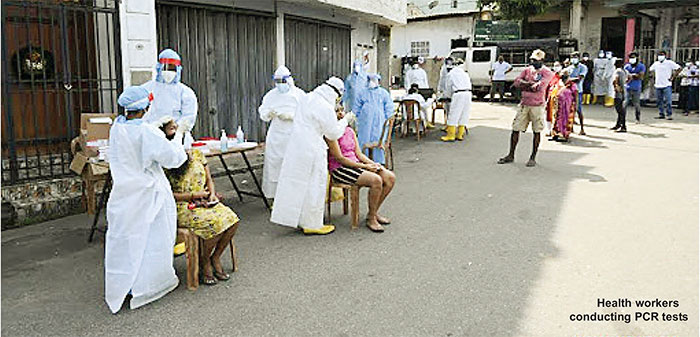News
Coronavirus far more prevalent than indicated by PCR testing statistics

A seroprevalence rate of 24.5% was seen in all age groups in the CMC in the end of January 2021, a research carried by Sri Lankan and British researchers has revealed. This is a much higher number than what the PCR tests indicated.
The research was carried out in the Colombo city, which experienced the highest number of coronavirus cases until the end of January 2021, the researchers have said. Although Sri Lanka had successfully contained the pandemic until the end of September, with no locally detected cases from August to September 2020, an explosive spread began during early October, which rapidly spread across the country.
“However, as Colombo is the commercial capital of the country, and also due to extremely overcrowded living conditions, 32,346/89,817 (36.01%) locally detected cases by the end of March 2021, were from Colombo. Of the cases in the Colombo District, 14,416 (44.6%) were identified within the city. We carried out a serosurvey prior to initiation of the vaccination programme to understand the extent of the SARS-CoV-2 outbreak”, they said.
The researchers added that although the seropositivity rate was highest in the 10–20 age group (34.03%), the PCR positivity rate was 9.80%. Therefore, the PCR positivity rates appear to underestimate the true extent of the outbreak and the age groups which were infected. They said that in many countries, the reported number of cases did not necessarily reflect the extent of the outbreak, age groups infected and groups at risk, as the majority of infections were asymptomatic and limitations in carrying out quantitative real-time PCR for SARS-CoV2. It has been estimated that surveillance of SARS- CoV2 with qRT-PCR alone may underestimate the true prevalence by tenfold.
“Differences in the PCR positivity rates and seropositivity rates were also seen in 60–70-year-olds (8.90 vs 30.4%) and in individuals 70 years (4.10 vs. 1.20%). The seropositivity rate of the females was 29.70% (290/976), which was significantly higher than in males 21.2% (333/1,571), the researchers said.
It is important to carry out serosurveillance studies to understand the true extent of an outbreak in order to understand the future outbreaks that may occur in a particular area and to further understand transmission dynamics and duration of immunity, the researchers have said.
“Based on the seropositivity rates of 24.46%, 138,276 individuals are likely to have been infected, compared to the reported PCR positive cases of 14,416. Therefore, infection detection rates by PCR appeared to have underestimated the actual number of infections by 9.59-fold, which is not surprising as the random PCRs were mainly carried out in the working population and less frequently in those who were confined to their houses.” They claimed that as samples for PCR were obtained on only certain days of the week when the team visited the housing complexes and residential areas, the population who underwent PCRs on most days mainly represented the working population. Blood samples were obtained from these participants at the same time when samples were taken from them for these routine random PCR testing for SARS-CoV-2. None of the participants had any symptoms at the time of obtaining blood samples and were not previously diagnosed as been infected with the SARS-CoV-2 virus.
The researchers further claimed that the Colombo city was divided into six districts: namely D1, D2A, D2B, D3, D4, and D5. Although the overall seroprevalence was 24.46%, certain districts in the CMC (D2A, D2B, and D3) had higher seroprevalence rates (26.2–39%) compared to D4 which only had a seroprevalence rate of 3.33%. These overall differences between the districts reflected the population density and the housing conditions in these districts, with the districts with high seroprevalence having more overcrowded areas, with poor housing conditions. The differences in the seroprevalence rates in different districts could also be due to differences in the control measured adopted. For instance, in D1, although the seroprevalence was 14.76%, certain areas in this district had a very high infection rate as determined by PCR positivity. Due to early detection of SARS-CoV-2 infection in certain areas in this district, these areas were isolated very early, and therefore, it would have curtailed the spread to the rest of the D1 district resulting in fewer infections. Such similar differences have been observed in many states in India, where the slum areas reported seroprevalence rates between 52.6 to 58.7% compared to 12–17.9% in non-slum areas Although the overall seroprevalence rates in the CMC was less than urban areas in India, it was higher than many areas in Europe (Spain, Sweden, Switzerland, and Germany), which reported a seroprevalence between 5 to 13.6% and Iran (22.16%), which reported higher infection rates (14–17). However, the use of different antibody assays, which had a varying degree of sensitivity and specificities in these different studies could result in such differences.
Chandima Jeewandara, Dinuka Guruge, Inoka Sepali Abyrathna, Saubhagya Danasekara, Banuri Gunasekera, Pradeep Darshana Pushpakumara, Deshan Madhusanka, Deshni Jayathilaka, Thushali Ranasinghe, Gayasha Somathilake, Shyrar Tanussiya, Tibutius Tanesh Jayadas, Heshan Kuruppu, Nimasha Thashmi, Michael Harvie, Ruwan Wijayamuni, Lisa Schimanski, T. K. Tan, Pramila Rijal, Julie Xiao, Graham S. Ogg, Alain Townsend and Gathsaurie Neelika Malavige were the researchers involved. (RK)